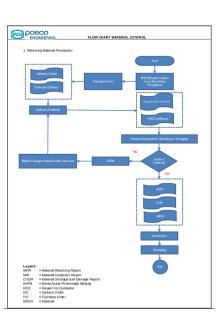JOB - pakistan history flowchart PDF

| Title | JOB - pakistan history flowchart |
|---|---|
| Course | Basic electronics |
| Institution | University of Sargodha |
| Pages | 5 |
| File Size | 314.8 KB |
| File Type | |
| Total Downloads | 43 |
| Total Views | 140 |
Summary
pakistan history flowchart...
Description
JOB # 7 TO SET OUT SIMPLE CIRCULAR CURVE
1. Apparatus:
Digital electronic 0 5 ' '
Hammer and Pegs
Tripod stand
Fibre glass tape
Ranging Rods
Theodolite
2. Objective: The object of this job is to join two tangents (railways,roads) by a curve of constant radius fo the purpose of easy change of direction. 3. Terminologies used in simple curve PC = Point of curvature. It is the beginning of curve. PT = Point of tangency. It is the end of curve. PI = Point of intersection of the tangents. T = Length of tangent from PC to PI and from PI to PT. It is known as subtangent. R = Radius of simple curve, or simply radius. L = Length of chord from PC to PT. Point Q as shown in the the figure is the midpoint of
L.
Lc = Length of curve from PC to PT. Point M as shown in the the figure is the midpoint of
Lc.
E = External distance. It is the nearest distance from PI to the curve. From the above figure, point M is the midpoint of the curve and E is the distance from PI to M. m = Middle ordinate. It is the distance from the midpoint of the curve to the midpoint of the chord. From the figure above, m is the distance MQ. I = Deflection angle (also called angle of intersection and central angle). It is the angle of intersection of the tangents. The angle subtended by PC and PT at O is also equal to I, where O is the center of the circular curve from the above figure. x = offset distance from tangent to any point in the curve; note that x is perpendicular to T. θ = offset angle subtended at PC between PI and any point in the curve
D = Degree of curve. It is the central angle subtended by a length of curve equal to one station. In English system, one station is equal to 100 ft and in SI, one station is equal to 20 m. Sub chord = chord distance between two adjacent full stations.
3.1 Sharpness of circular curve The smaller is the degree of curve, the flatter is the curve and vice versa. The sharpness of simple curve is also determined by radius R. Large radius are flat whereas small radius are sharp.
3.2 Formulas for Circular Curves The formulas we are about to present need not be memorized. All we need is geometry plus names of all elements in simple curve. Note that we are only dealing with circular arc, it is in our great advantage if we deal it at geometry level rather than memorize these formulas. For easy reference, the figure shown in the previous page will be shown again here.
3.3 Length of tangent, T Length of tangent (also referred to as subtangent) is the distance from PC to PI. It is the same distance from PI to PT. From the right triangle PI-PT-O,
3.4 Apex Distance: External distance is the distance from PI to the midpoint of the curve. From the same right triangle PI-PT-O,
3.5 Verse Sine Distance: Verse Sine distance is the distance from the midpoint of the curve to the midpoint of the chord. From right triangle O-Q-PT,
3.6 Length of long chord, L Length of long chord or simply length of chord is the distance from PC to PT. Again, from right triangle O-Q-PT,
3.7 Length of curve, Lc Length of curve from PC to PT is the road distance between ends of the simple curve. By ratio and proportion,
SI units: 1 station = 30 m English system: 1 station = 100 ft
3.8 Degree of curve, D The degree of curve is the central angle subtended by an arc (arc basis) or chord (chord basis) of one station. It will define the sharpness of the curve. In English system, 1 station is equal to 100 ft and in SI, 1 station is equal to 30 m. 4. Setting Out Simple Circular Curve In this method, curves are staked out by use of deflection angles turned at the point of curvature from the tangent to points along the curve. The curve is set out by driving pegs at regular interval equal to the length of the normal chord. Usually, the sub-chords are provided at the beginning and end of the curve to adjust the actual length of the curve. The method is based on the assumption that there is no difference between length of the arcs and their corresponding chords of normal length or less. The underlying principle of this method is that the deflection angle to any point on the circular curve is measured by the one-half the angle subtended at the centre of the circle by the arc from the P.C. to that point
Let points a, b, c, d, e are to be identified in the field to layout a curve between T1 and T2 to change direction from the straight alignment AV to VB as in Figure 38.1(a). To decide about the points, chords ab, bc, cd, de are being considered having nominal length of 30m. To adjust the actual length of the curve two sub-chords have been provided one at the beginning, T1 a and other, eT2 at the end of the curve. The amount of deflection angles that are to be set from the tangent line at the P.C. are computed before setting out the points. 5.
Viva Voce:
Q 1 : why is a curve provided ? Ans : To provide a smooth path for the traffic and for the convenience of passengers. It is also used fro easy change of direction. Q 2: What is the relation between radius and degree of curve? Ans: Radius= 1718.9/D where D=Degree of curve Q 3: What is the versed sine of curve? Ans: Versed sine of curve= R(1-Cosɸ/2) Q 4: Relation between unit chord and radius? Ans: The length of unit chord should be 1/20th of the radius. Q5: What is the radius of one degree of curve? Ans: The radius of one degree curve is 1718.9 m Q6: What is formula for apex distance? Ans: Apex distance=R(Secɸ/2-1) Q7: The length of long chord is given by……….? Ans: Our required relation is L=2RSinɸ/2 Q8: What is meant by 5o curve? Ans: It means that a chord length of 30 m of a curve makes an angle of 5o at the center Q9: Chainage of second point of S.S.C. is given by ? Ans: Chainage of first point + length of curve . Q10: Tangent Length of S.S.C is given by ? Ans : R tan ɸ/2...
Similar Free PDFs
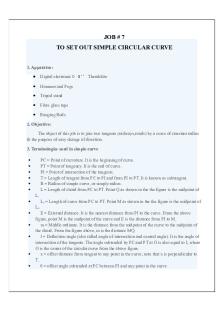
JOB - pakistan history flowchart
- 5 Pages
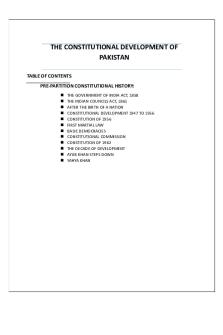
Constitutional History of pakistan
- 16 Pages
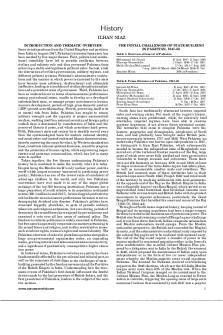
History Of Pakistan 1947-2017
- 15 Pages

History (Of Pakistan, 1947-2019)
- 16 Pages

Pakistan History by M.R Kazmi
- 69 Pages
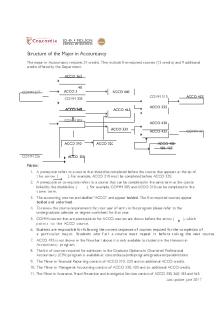
Flowchart-acco - flowchart
- 1 Pages

Flowchart
- 8 Pages
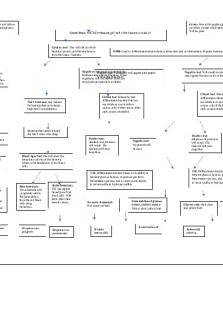
Flowchart
- 1 Pages

Negligence Flowchart
- 3 Pages

Bab02 Flowchart
- 7 Pages
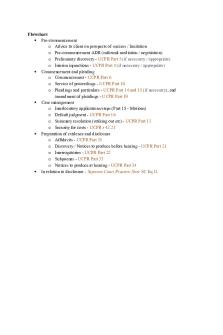
civil Flowchart
- 2 Pages
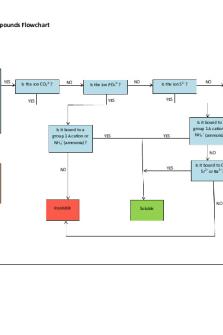
Solubility Flowchart
- 2 Pages

Flowchart Jurnal
- 13 Pages
Popular Institutions
- Tinajero National High School - Annex
- Politeknik Caltex Riau
- Yokohama City University
- SGT University
- University of Al-Qadisiyah
- Divine Word College of Vigan
- Techniek College Rotterdam
- Universidade de Santiago
- Universiti Teknologi MARA Cawangan Johor Kampus Pasir Gudang
- Poltekkes Kemenkes Yogyakarta
- Baguio City National High School
- Colegio san marcos
- preparatoria uno
- Centro de Bachillerato Tecnológico Industrial y de Servicios No. 107
- Dalian Maritime University
- Quang Trung Secondary School
- Colegio Tecnológico en Informática
- Corporación Regional de Educación Superior
- Grupo CEDVA
- Dar Al Uloom University
- Centro de Estudios Preuniversitarios de la Universidad Nacional de Ingeniería
- 上智大学
- Aakash International School, Nuna Majara
- San Felipe Neri Catholic School
- Kang Chiao International School - New Taipei City
- Misamis Occidental National High School
- Institución Educativa Escuela Normal Juan Ladrilleros
- Kolehiyo ng Pantukan
- Batanes State College
- Instituto Continental
- Sekolah Menengah Kejuruan Kesehatan Kaltara (Tarakan)
- Colegio de La Inmaculada Concepcion - Cebu

